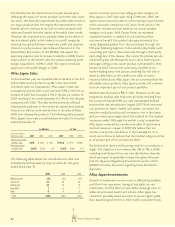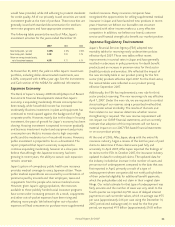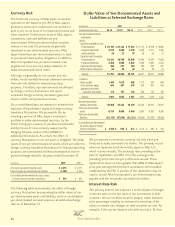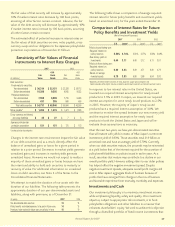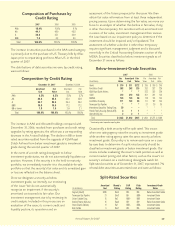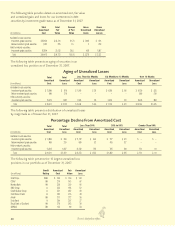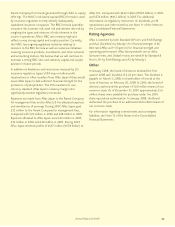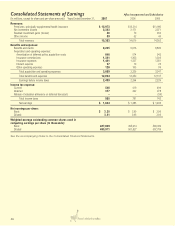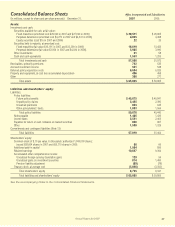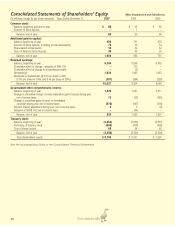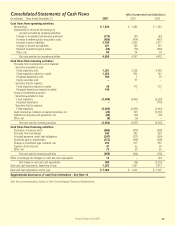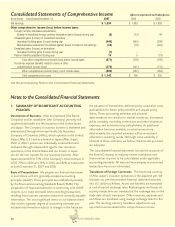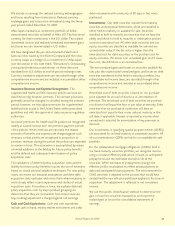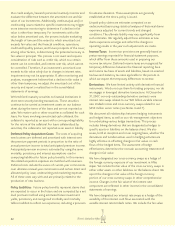Aflac 2007 Annual Report Download - page 46
Download and view the complete annual report
Please find page 46 of the 2007 Aflac annual report below. You can navigate through the pages in the report by either clicking on the pages listed below, or by using the keyword search tool below to find specific information within the annual report.
42 There’s Only One Aflac
designated the Parent Company’s yen-denominated liabilities
(Samurai and Uridashi notes payable and cross-currency
swaps) as a hedge of our investment in Aflac Japan. If the total
of these yen-denominated liabilities is equal to or less than
our net investment in Aflac Japan, the hedge is deemed to be
effective and the related exchange effect is reported in the
unrealized foreign currency component of other
comprehensive income. Should these yen-denominated
liabilities exceed our investment in Aflac Japan, the portion of
the hedge that exceeds our investment in Aflac Japan would
be deemed ineffective. As required by SFAS No. 133, we
would then recognize the foreign exchange effect on the
ineffective portion in net earnings (other income). We
estimate that if the ineffective portion was ¥10 billion, we
would report a foreign exchange gain/loss of approximately
$1 million for every one yen weakening/strengthening in the
end-of-period yen/dollar exchange rate. At December 31,
2007, our hedge was effective with yen-denominated assets
exceeding yen-denominated liabilities by ¥105.2 billion,
compared with ¥105.4 billion at December 31, 2006.
We have interest rate swap agreements related to the ¥20
billion variable interest rate Uridashi notes. By entering into
these contracts, we have been able to lock in our interest rate
at 1.52% in yen. We have designated these interest rate swaps
as a hedge of the variability in our interest cash flows
associated with the variable interest rate Uridashi notes. The
notional amounts and terms of the swaps match the principal
amount and terms of the variable interest rate Uridashi notes,
and the swaps had no value at inception. Changes in the fair
value of the swap contracts are recorded in other
comprehensive income. The fair value of these swaps and
related changes in fair value were immaterial during the years
ended December 31, 2007 and 2006. See Note 4 of the Notes
to the Consolidated Financial Statements for additional
information.
Off Balance Sheet Arrangements
As of December 31, 2007, we had no material unconditional
purchase obligations that were not recorded on the balance
sheet. Additionally, we had no material letters of credit, standby
letters of credit, guarantees or standby repurchase obligations.
CAPITAL RESOURCES AND LIQUIDITY
Aflac provides the primary sources of liquidity to the Parent
Company through dividends and management fees. Aflac paid
dividends to the Parent Company in the amount of $1.4 billion
in 2007, compared with $665 million in 2006 and $526 million
in 2005. During 2007, Aflac paid $80 million to the Parent
Company for management fees, compared with $68 million in
2006 and $73 million in 2005. The primary uses of cash by the
Parent Company are shareholder dividends and our share
repurchase program. The Parent Company’s sources and uses
of cash are reasonably predictable. For additional information,
see the Financing Activities section of this MD&A.
The Parent Company also accesses debt security markets to
provide additional sources of capital. Capital is primarily used
to fund business expansion and capital expenditures. We have
a Shelf Registration Statement (SRS) on file with Japanese
regulatory authorities to issue up to ¥100 billion of yen-
denominated Samurai notes in Japan. In June 2007, the Parent
Company issued ¥30 billion of yen-denominated Samurai
notes from this SRS. If issued, the remaining ¥70 billion
(approximately $613 million using the December 31, 2007,
period-end exchange rate) of yen-denominated Samurai notes
will not be available to U.S. persons. We also have an SRS on
file with Japanese regulatory authorities to issue up to ¥100
billion of Uridashi notes in Japan. In September 2006, the
Parent Company issued ¥45 billion of yen-denominated
Uridashi notes from this SRS. If issued, the remaining ¥55
billion (approximately $482 million using the December 31,
2007, period-end exchange rate) of yen-denominated Uridashi
notes will not be available to U.S. persons. We believe outside
sources for additional debt and equity capital, if needed, will
continue to be available. For additional information, see Note
7 of the Notes to the Consolidated Financial Statements.
The principal sources of cash for our insurance operations are
premiums and investment income. The primary uses of cash
by our insurance operations are policy claims, commissions,
operating expenses, income taxes and payments to the Parent
Company for management fees and dividends. Both the
sources and uses of cash are reasonably predictable.
When making an investment decision, our first consideration is
based on product needs. Our investment objectives provide for
liquidity through the purchase of investment-grade debt
securities. These objectives also take into account duration
matching; and, because of the long-term nature of our business,
we have adequate time to react to changing cash flow needs.
As a result of policyholder aging, claims payments are
expected to gradually increase over the life of a policy.
Therefore, future policy benefit reserves are accumulated in
the early years of a policy and are designed to help fund
future claims payments. We expect our future cash flows from
premiums and our investment portfolio to be sufficient to
meet our cash needs for benefits and expenses.
The following table presents the estimated payments by
period of our major contractual obligations as of December
31, 2007. We translated our yen-denominated obligations
using the December 31, 2007, exchange rate. Actual future
payments as reported in dollars will fluctuate with changes in
the yen/dollar exchange rate.


